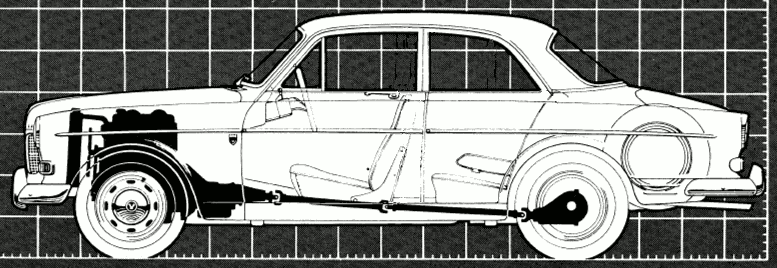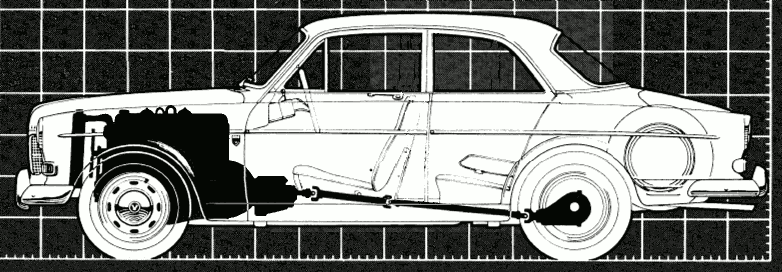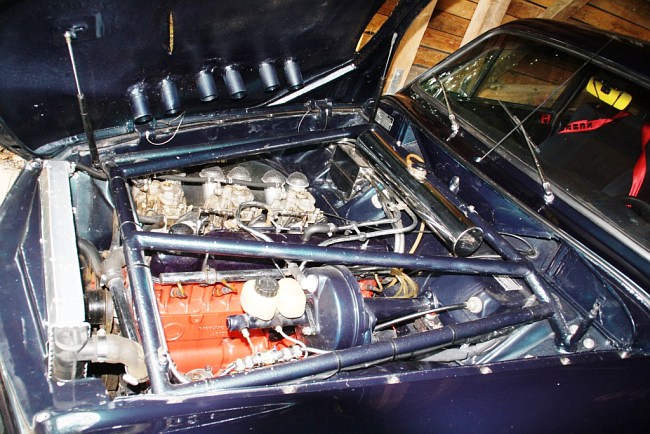
Note: This project may not be happening for a bit... I've just got a 164, and it's a good one which is now back on the road, it's not a wreck only good for spares. To have three cars around, two of them not moveable - the good 164 being restored, a knackered 164 being dismantled and an Amazon with extensive bodyshell mods in progress - would strain my facilities somewhat. No doubt a dead 164 will fall into my lap some day but for now sorting out the good one will have to take priority.
Greetings to everyone from amazon.forum.bilia.se and thanks for your interest! I hope you like this page. I wish I knew Swedish because some of the projects on your forum look most interesting!
Yes, this page is about Volvos - about my thoughts on fitting a Volvo Amazon with the six-cylinder B30 engine. But first, some background as to the origin of the idea, in the form of a lot of stuff about CDs.
Elsewhere on this site I discuss the quantum phenomena exhibited by macroscopic-sized objects, an area which I feel has not received the attention it deserves. (On the other hand, this includes the CIA not knowing about it. Which is probably a bloody good thing. If they do begin researching it, readers of this site will be the first to know.)
A particular case mentioned is the fact that CDs can exhibit tunnelling behaviour. The wave function which defines the position of the CD in space can have anomalous maxima at some considerable distance from the point conventionally thought of as being the location of the CD. The result is that the CD can effectively disappear from one place and reappear at another - the location of an anomalous maximum - because in some sense it might be there already. It is for this reason that CDs should always be kept in their cases, because the interaction of the wave function of the CD with that of the case provides some stabilising effect (admittedly not very great) which inhibits tunnelling, so you are less likely to lose your CDs.
It doesn't prevent it completely, though. It is still possible for the CD to tunnel out of its case, or alternatively for the whole kit and caboodle – CD plus case plus booklet etc. – to tunnel as a complete entity. This is what happened to my CD of The Final Cut, by Pink Floyd. This CD was rather badly scratched and wouldn't play reliably any more, so I took advantage of the ability of a computer CD drive to retry reading bad sectors to recover the data and burn it to a CD-R. This CD-R, labelled "The Final Cut" in black marker, was stowed in the regular CD stowage area of the case, while the original scratched CD was tucked inside the lyrics booklet. The outside of the case had something of the appearance of having been at the bottom of a river, though this was not the actual cause of its manky condition.
I was inspired to write my Joey Deacon page by something that had taken place when playing this CD, and so I decided to play it again, loudly, while writing the page. I had played it only a few days before so it had not had time to work its way very far down in the pile of CDs... or so I thought. But it didn't grace the pile, in fact it wasn't there at all. I traced all the classical paths by which it could have left the pile and attained a position of lower gravitational potential energy, but found the floor to be devoid of CDs. The bloody thing was simply no longer anywhere in the room.
Tracing the quantum paths by which it could have left the pile is a task of considerably greater magnitude, but I am not without means of detecting and analysing anomalous quantum events. Integrating the data from the appropriate streams at around the possible time of the event (a reasonably large window, given that it was a few days since the CD was last observed to be in the pile) and passing it into a Bayesian classifier gave a probability distribution for the shape of the wave function involved in the tunnelling event which showed a certain increased probability approximately along the line of the M3 or the LSWR (Waterloo-Bournemouth) main line, so my sodding CD might be a hundred miles away now.
So it seemed I had some interesting new results for the Pigeon quantum research programme, but on the other hand the loss of the CD had fucked up the proposed music to accompany my web page authoring activities. Nothing daunted, I fired up the P2P client and soon a replacement copy, compressed using a lossless method (none of this fucking MP3 shit), was buzzing down the wires. I then selected some alternative music – I can't remember what, but I'd think it would be something which could with advantage be used to give the speakers an Italian tuneup, like Jethro Tull's The Broadsword and the Beast or Camel's Stationary Traveller – and got on with my HTML-encoded Deaconic reminiscenses.
That was sufficiently long ago now that people are beginning to find the Joey Deacon page with Google. This evening I decided that the theme of the next few hours should be late Pink Floyd. I would start with Animals, then The Wall, then The Final Cut (the replacement copy), then since the subsequent Floyd albums following Roger Waters's departure are essentially David Gilmour solo albums it would be logical to play About Face before moving on to A Momentary Lapse of Reason if the urge to play Barclay James Harvest hadn't grown too strong by then. However, the process hit a snag. Animals, a cheap CD-R in a plastic envelope-type sleeve with the title and track list written on it in black marker, was nowhere to be found. Like the original The Final Cut, it had been near the top of the pile of CDs having been played only a few days before, and like The Final Cut the bloody thing had tunnelled out of my room altogether.
Now it has to be said that the quantum-processing system load occasioned in connection with the reception of quantum steganographic data on the 31st of July 2006, and the extensive and distributed processing thereafter required by said data, had been showing some noteworthy peaks, with extremely high CPU loads being recorded on the night of Thursday 5th - Friday 6th October 2006, the night preceding the discovery of the tunnelling event undergone by the Animals CD. Rather as the stray radiation from the operation of an electronic processor can cause anomalous effects in other nearby electronic devices (like not being able to watch Channel 5 with the PC on), the operation of quantum processing devices at high load can give rise to anomalous fluctuations in the wave functions of nearby objects. The anomalous macroscopic wave functions are affected much more strongly than the conventional atomic-scale ones, so I don't have to deal with my room getting radioactive, but I do have to deal with my fucking CDs going missing.
Even with high levels of quantum activity data to operate on, Bayesian reconstruction of the wave function is not generally very precise. Current techniques have not yet attained the point of being able to reconstruct the precise form of the wave function; the best currently possible is only a probability distribution of all the forms the wave function might have taken. However, as with the case of The Final Cut, the distribution does have a statistically significant region of higher probability, again inconveniently far to the South of me but differently aligned to the previous one, in such a way as to move the peak of the probability distribution towards the Southern end of the previous track. This doesn't narrow it down as much as it sounds like it does, as the tracks are so wide that it doesn't really pinpoint a particular location, more "it's down South somewhere between London and the Needles". The second track is particularly fuzzy and broad. And it's not definite even that it went there, just more likely than Scotland, or going out along the reciprocal trajectory and landing in the North Sea.
As I type this part of the page I am playing Pyramid by the Alan Parsons Project, and the lyrics "What's been lost must be found" have just been sung. How appropriate, came the thought, for writing about lost CDs which I would like to recover. It is true that, as related above, The Final Cut has been replaced, and in the case of Animals I already had a backup; but the manner of the CDs' disappearance means that the data associated with their recovery would be of considerably more interest than the musical data which was lost (and has already been recovered). Not only would it be possible to make the Bayesian classification of wave functions a lot more accurate, the general impact on macroscopic quantum mechanical research would be of great moment. So if you occasionally discover random Pink Floyd CDs turning up in your house, please get in touch. In order that subsequent CD tunnelling events do not bring such associated communications problems connected with their recovery, I have now taken to writing my email address and website URL on all my CDs as they go through the player. I have also created backups, both on-site and distributed off-site, of my Barclay James Harvest CDs. Lossless copies of BJH albums on P2P networks are rare, and I would be devastated to lose any CDs of my favourite band. Indeed, given that my attachment to the music of Barclay James Harvest causes these CDs to undergo a playing regime that exposes them to high levels of environmental quantum fluctuations, I'm rather surprised that it's the Pink Floyd CDs that have been going missing. Update: Full list of missing CDs here.
Research into anomalous quantum phenomena necessarily involves much work with probabilities that cannot always be calculated with any accuracy, and the habit tends to spread into other walks of life. Hence I am not ruling out the possibility of the requirement arising to physically go and collect the CDs. One could imagine that Osama Bin Laden or some other looney might make the realisation that CD cases make ideal housings for letter bombs. Triggered by opening the lid of the CD case, a CD-sized disc of plastic explosive could cause considerable damage; the void down the hinge side of the case makes an ideal place to fit a battery and a detonation control circuit to defeat attempts to defuse the bomb. The practical application of this discovery might result in all postal packages which look like they might have CDs in them being subjected to controlled detonation. I'd have no option then as it would be impossible for the CDs to be posted to me.
"Kind of down South somewhere" is not an area I've had much to do with. Anywhere in the area South of the M4 / East of the A338 is more or less a closed book to me; for some reason it's just turned out that I could count the trips I have made to that area on the primaries of one wing. I have an auntie who lives in the "zone of mystery" but though I have seen her relatively recently I haven't been to visit her at home since I was about 5, maybe less; I remember my cousin, a few years older than me, had a really cool chemistry set. I have been to a place near Brighton to buy a lathe. I have been to Kent on business, discussing LED lighting controllers. I have been to Winchester once, many years ago, to visit a mate who lived there. He went off to be a Buddhist monk and I haven't seen him since. And that's about it.
Now while it is true that I have my MZ, and a bloody good motorcycle it is, or I could even go by train (as when visiting my mate, when I had the pleasure of a pair of EDs double-heading), I feel that a different mode of transport would be appropriate for such a momentous task. One with four wheels and an appropriate degree of quality and comfort. While it is tempting to consider such machines as the XJ-S V12, their alarming tendency to dissolve in the damp and their complex construction which impedes the repair of the damage is somewhat offputting, and really there can be only one serious contender - the Volvo Amazon, two-door saloon version. These are supremely high quality cars with a refreshingly complete lack of bullshit. Although they are solid as a rock they only weigh a few stone over the ton because they are intelligently designed with all the weight being put to good structural use. The mechanical components are of sufficiently high quality to hold the world record for mileage for a car (the record holder is the mechanically identical P1800). And there is no better vehicle for a long journey on a wintry night than a Volvo, with its nuclear heater and its anatomically-optimised seats - pioneered by Volvo, who got it bloody well right first time.
The Amazon has only one failing: not enough cylinders. Though the B18/B20 units are powerful by the standards of the time (and still not too bad these days), torquey, tunable and incredibly robust, they are still only inline fours, with the inline four's inherent lack of balance. The requirement in this instance is for the cylinders to be arranged in one or more banks of six, hence the consideration of the XJ-S. Such an engine has inherent balance and is smooth and powerful with a fine torque curve. But although a straight six was one of the power unit options considered for the original design, the Amazon was only ever manufactured with a four-pot. For the return of an inline six to the Volvo range we had to wait for the Volvo 164, which began production in 1968, two years before the Amazon stopped.
And herein lies the solution. The straight six in the 164, designated B30, is nothing more than the Amazon's B20 unit multiplied by 1.5. In terms of their mechanical interconnection, all the drivetrain components of the 164 and the Amazon are compatible and interchageable (apart from the sodding bellhousing, bugger it). With only two years of production left to go, Volvo never thought it was worthwhile putting the B30 in the Amazon, but I think it is. The Pigeon viewpoint is not the same as the Volvo one.
No doubt some will think that this is somewhat in the nature of overkill for a trip to retrieve CDs. This is not the case. It is the kind of journey more suited to a six-cylinder Amazon than to an MZ, and given the kind of thrashing the MZ would receive on continuous fast roads the Volvo wouldn't end up using all that much more fuel. Furthermore, since I have no intention of ceasing to operate quantum processing systems it is likely that I shall have to deal with the loss of further CDs, their recovery being eased both by the Volvo and by the presence of my email address written on them. Given a sufficiently prolonged period of extreme CPU load it is not inconceivable that I might receive an email along the lines of Hello Pigeon, there was one of your fucking CDs in the kettle this morning, another one in the cat's litter tray and one in between every slice of the loaf of bread. And there's a pigeon in the bathroom with a thing with wires on its back and the police are calling the army to blow it up. I'd have to beat the bomb squad to the scene in order to save the life of the pigeon, and that would need a six-cylinder Volvo, not an MZ.
Another possible objection to my plan would be "why not just get a Volvo 164"? Well, that possibility has been under consideration for some time... and now, as mentioned above, I've done it. It's a lovely car, sublimely relaxing to drive, with a steering feel strongly reminiscent of caressing the bare shoulders of a beautiful woman. Moreover, the disappearance through tunnelling of the circuit diagram for the electric fan thermostat has provided more data for the quantum research project, and another unlabelled vanished item now needs to be retrieved. As a CD-recovery vehicle it is eminently suitable - perhaps more suitable than an Amazon, with its considerably greater interior comfort and fully-reclining front seats. However, if I'm going to be both pedantic and petrolheaded about it, there are quite a few reasons to prefer the Amazon conversion:


